da Hornet: A Cult Classic Virtual Analog Synth by NUSofting
Introduction: Legendary Sound in Your DAW
In the world of software musical instruments, there are plugins that quickly achieve the status of true “cult classics.” This is precisely the case with da Hornet from developer NUSofting. This virtual analog (VA) synthesizer has won the hearts of many musicians and producers thanks to its exceptional sound. It offers a warm, rich, and extremely musical timbre reminiscent of legendary hardware synthesizers of the past. If you value a vintage character combined with the flexibility and convenience of the digital format, da Hornet is an instrument that definitely deserves your attention.
What is Virtual Analog Synthesis?
Virtual analog synthesis is an advanced technology that allows software instruments to accurately imitate the behavior, features, and rich sound of classic hardware analog synthesizers. Unlike samplers, which simply reproduce recorded sounds, VA synths generate sound “from scratch” using complex mathematical models that simulate the operation of electronic circuits. This provides incredible flexibility in shaping timbres, allowing you to dynamically change each sound parameter in real-time, as when working with a physical synthesizer. Da Hornet is an excellent example of the implementation of this technology, offering depth, complexity, and “liveliness” of timbres that are so highly valued in modern music.
Features of da Hornet
Although da Hornet may seem minimalistic at first glance, a powerful sound engine is hidden under its “hood”, capable of creating impressive timbres. As a typical representative of classic VA synthesis, it includes all the key elements for deep sound shaping:
Sound Generators (Oscillators)
The heart of any synthesizer is its oscillators, which generate the initial sound wave. In da Hornet, as in many classic VA synths, you will find the ability to work with models of standard waveforms – sawtooth (Saw), square (Square), sine (Sine) and, probably, others. By combining, adjusting, and modulating these oscillators, you can create extremely rich and complex timbres – from dense basses and piercing leads to airy pads and experimental soundscapes.
Filters
Filters are one of the most influential elements in shaping the character of a synthesizer’s sound. In da Hornet, high-quality filters are implemented, which masterfully imitate the non-linear behavior and unique “character” of analog circuits. Typically, these are resonant low-pass filters (Low-Pass Filter), which allow you to “cut” the upper harmonics, making the sound softer, or, conversely, add a distinct, singing resonance at the cutoff frequency. Dynamic change of the cutoff frequency and resonance is the basis for creating those same “moving” and “live” timbres that are associated with classic analog synthesizers.
Envelopes
Envelopes control how different sound parameters (most often volume or filter frequency) change over time after a key is pressed. A standard ADSR-envelope (Attack, Decay, Sustain, Release) allows you to shape the dynamics of the sound – from fast, “plucked” attacks for bass and percussion, to slow, smooth rises for pads and atmospheric sounds, and also control the duration of the sustain and decay of the sound after releasing the key (Release). The presence of several envelopes allows you to simultaneously control different aspects of the timbre, adding complexity and expressiveness to it.
Low Frequency Oscillators (LFO) and Modulation
Low-frequency oscillators (LFO) generate slow, inaudible oscillations that are used to modulate other sound parameters. This can create effects such as vibrato (pitch modulation), tremolo (volume modulation), wah-wah (filter frequency modulation), and much more. The modulation system in da Hornet, as in any flexible synthesizer, allows you to assign LFOs and envelopes to different targets, opening up a wide space for sound design, experimentation, and the creation of unique, moving timbres that change over time.
Why da Hornet Has Gained Cult Classic Status?
There are several reasons why this plugin has been loved by many and has received the status of a “cult classic.” First, it’s its authentic analog sound. In a world where many digital instruments can sound somewhat sterile or “plastic,” da Hornet offers warmth, depth, unpredictability, and “organic” character, which is associated with the best hardware analog synthesizers. Secondly, it’s its simple, yet extremely effective interface design. It’s not overloaded with unnecessary features, allowing you to quickly master the instrument and focus specifically on creating music and sounds, rather than navigating through complex menus. It’s a reliable “workhorse” that simply works and sounds great.
Integration and Compatibility
NUSofting da Hornet is designed as a VST plugin, which is one of the most common formats in the world of software musical instruments. It is supported by Windows (Win32) and MacOS (OSX) operating systems, which ensures its compatibility with the vast majority of modern digital audio workstations (DAW), such as Ableton Live, FL Studio, Cubase, Logic Pro (usually through VST-shells on Mac), Reaper and many others. The plugin installation process is standard and usually does not cause any difficulties.
Conclusion
NUSofting da Hornet is not just another virtual synthesizer. It is an instrument with history, character, and a unique sound. Its “cult classic” status is fully justified by its ability to reproduce a warm, rich analog sound that inspires. The combination of this sound with an intuitive interface and wide compatibility makes it a great addition to the arsenal of any modern producer or musician. If you are looking for a high-quality virtual analog synthesizer that will add depth, warmth, and authentic character to your tracks, da Hornet from NUSofting is a choice that will not disappoint you. Try it and discover for yourself why this plugin has gained such love among musicians around the world.



